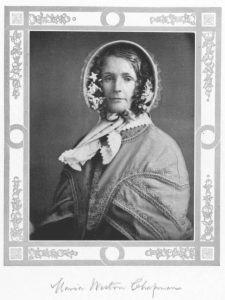By Heather Rockwood, Communications Associate
“A challenged world is an alert world and from challenge comes change.”
– Maria Weston Chapman

On International Womens Day 2021, meet a woman who chose to challenge the practice of slavery in the United States, Maria Weston Chapman.
Chapman and her sisters Caroline and Anne from Weymouth, Mass., were active abolitionists. Through their “kin-work”, the sisters supported each other through family responsibilities in order to take their active public roles. By taking up the cause of abolition they endured pro-slavery mobs, social ridicule, and public attacks on their characters.
Chapman edited and published The Liberty Bell, an annual abolitionist gift book to be sold or gifted to participants in the Boston Anti-Slavery Bazaar, which Chapman lead. This book was published almost every year from 1839 to 1858.
In addition to her work on The Liberty Bell and the Bazaar, between 1835 and 1865, Chapman served on the executive and business committees of the Massachusetts Anti-Slavery Society, the New England Anti-Slavery Society (NEASS) and the American Anti-Slavery Society (AASS). She wrote the annual reports of the Boston Female Anti-Slavery Society (BFASS) and published tracts to raise public awareness.
She also served as editor to The Liberator in William Lloyd Garrison’s absence, and was on the editorial committee of the National Anti-Slavery Standard, the official mouthpiece of the AASS. Chapman was also a member of the peace organization, the Non-Resistance Society, which published The Non-Resistant.
Chapman was a prolific writer, writing most of the content of The Liberty Bell and publishing Right and Wrong in Massachusetts in 1839 and “How Can I Help to Abolish Slavery?” in 1855. Aside from these works, she published her poems and essays in abolitionist periodicals.

